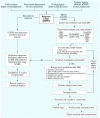An update on cancer cluster activities at the Centers for Disease Control and Prevention
- PMID: 17366838
- PMCID: PMC1797849
- DOI: 10.1289/ehp.9021
An update on cancer cluster activities at the Centers for Disease Control and Prevention
Abstract
The Centers for Disease Control and Prevention (CDC) continues to be aware of the need for response to public concern as well as to state and local agency concern about cancer clusters. In 1990 the CDC published the "Guidelines for Investigating Clusters of Health Events," in which a four-stage process was presented. This document has provided a framework that most state health departments have adopted, with modifications pertaining to their specific situations, available resources, and philosophy concerning disease clusters. The purpose of this present article is not to revise the CDC guidelines; they retain their original usefulness and validity. However, in the past 15 years, multiple cluster studies as well as scientific and technologic developments have affected duster science and response (improvements in cancer registries, a federal initiative in environmental public health tracking, refinement of biomarker technology, cluster identification using geographic information systems software, and the emergence of the Internet). Thus, we offer an addendum for use with the original document. Currently, to address both the needs of state health departments as well as public concern, the CDC now a) provides a centralized, coordinated response system for cancer cluster inquiries, b) supports an electronic cancer cluster listserver, c) maintains an informative web page, and d) provides support to states, ranging from laboratory analysis to epidemiologic assistance and expertise. Response to cancer clusters is appropriate public health action, and the CDC will continue to provide assistance, facilitate communication among states, and foster the development of new approaches in duster science.
Figures


Similar articles
-
Adequacy of state capacity to address noncommunicable disease clusters in the era of environmental public health tracking.Am J Public Health. 2007 Apr;97 Suppl 1(Suppl 1):S163-9. doi: 10.2105/AJPH.2006.096453. Epub 2007 Apr 5. Am J Public Health. 2007. PMID: 17413060 Free PMC article.
-
Malaria Surveillance - United States, 2017.MMWR Surveill Summ. 2021 Mar 19;70(2):1-35. doi: 10.15585/mmwr.ss7002a1. MMWR Surveill Summ. 2021. PMID: 33735166 Free PMC article.
-
Investigating suspected cancer clusters and responding to community concerns: guidelines from CDC and the Council of State and Territorial Epidemiologists.MMWR Recomm Rep. 2013 Sep 27;62(RR-08):1-24. MMWR Recomm Rep. 2013. PMID: 24067663
-
Cancer clusters in the USA: what do the last twenty years of state and federal investigations tell us?Crit Rev Toxicol. 2012 Jul;42(6):474-90. doi: 10.3109/10408444.2012.675315. Epub 2012 Apr 21. Crit Rev Toxicol. 2012. PMID: 22519802 Free PMC article. Review.
-
Understanding cancer clusters.CA Cancer J Clin. 2004 Sep-Oct;54(5):273-80. doi: 10.3322/canjclin.54.5.273. CA Cancer J Clin. 2004. PMID: 15371285 Review.
Cited by
-
Evaluating geostatistical modeling of exceedance probability as the first step in disease cluster investigations: very low birth weights near toxic Texas sites.Environ Health. 2014 Jun 7;13(1):47. doi: 10.1186/1476-069X-13-47. Environ Health. 2014. PMID: 24906417 Free PMC article.
-
A decade of environmental public health tracking (2002-2012): progress and challenges.J Public Health Manag Pract. 2015 Mar-Apr;21 Suppl 2(Suppl 2):S23-35. doi: 10.1097/PHH.0000000000000181. J Public Health Manag Pract. 2015. PMID: 25621442 Free PMC article. Review.
-
Bayesian versus frequentist statistical inference for investigating a one-off cancer cluster reported to a health department.BMC Med Res Methodol. 2009 May 11;9:30. doi: 10.1186/1471-2288-9-30. BMC Med Res Methodol. 2009. PMID: 19426561 Free PMC article.
-
Colorectal carcinogenesis: Review of human and experimental animal studies.J Carcinog. 2009;8:5. doi: 10.4103/1477-3163.49014. J Carcinog. 2009. PMID: 19332896 Free PMC article.
-
Clusters of adolescent and young adult thyroid cancer in Florida counties.Biomed Res Int. 2014;2014:832573. doi: 10.1155/2014/832573. Epub 2014 Apr 28. Biomed Res Int. 2014. PMID: 24868551 Free PMC article.
References
-
- Alstadt J, Chen D-M, Getis A. 1998. Point Pattern Analysis. Available: http://www.nku.edu/~longa/cgi-bin/cgi-tcl-examples/generic/ppa/ppa.cgi
-
- Anselin L. 2001. SpaceStat 1.91 and SpaceStat Extension for Arcview. Available: http://www.terraseer.com/products/spacestat.html/
-
- Anselin L. 2003. GeoDa. Available: https://www.geoda.uiuc.edu/default.php/
-
- Anselin L. 2004. Review of Cluster Analysis Software. Springfield, IL:North American Association of Central Cancer Registries. Available: http://www.naaccr.org/index.asp?Col_SectionKey=9&Col_ContentID=281
-
- Anselin L, Syabri I, Kho Y. 2004. GeoDa: An Introduction to Spatial Data Analysis. Urbana-Champaign, IL:University of Urbana Champaign. Available: https://www.geoda.uiuc.edu/pdf/geodaGA.pdf
Publication types
MeSH terms
LinkOut - more resources
Full Text Sources
Miscellaneous

